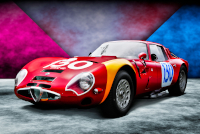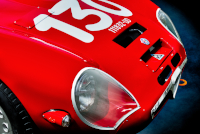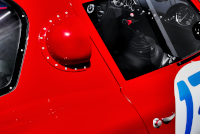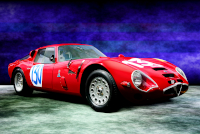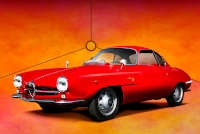Location:
Pebble Beach Concours d'Elegance, 2009
Owner: William H. Lyon Family | Newport Beach, California
Prologue:
Like so many, I have always found the TZ2's baby GTO aesthetic a trick bit of Italian esoterica. Finding one at Pebble Beach is not surprising, but still fortunate. In completing my old stock of Alfa Romeo, the chance to profile a TZ2 feels almost beyond my station in life, because this sports racing car is not so widely popular to warrant affection in the manner of Ferrari or Shelby cars, but among Alfisti it is a highly coveted treat.
Also, long ago we spotted a TZ, but I could not do much in the way of photographs at the time. So publishing this profile feels all the more like cheating for want of its predecessor. Four images, but they are sharp. In the first, I cleaned the Autodelta badges on the nose vent and the flank for the sake of the lines. These badges reappear in image 2 and image 4. And overall we get a sporting sense of the vents and traps and buttons that make racing cars of this era so pleasing to the eye.
- - - - - - - - - -
► Image Source: Nikon D200 (10.2 MP)
References:
- Czap, Nick. "Museo Storico Alfa Romeo: The Catalogue" Giorgio Nada Editore, Milano, Italia. 2015, page 140-141, 204-205
- UltimateCarPage: A brief bio on chassis #106, by Wouter Melissen, August 7, 2014.
- Sports Car Digest: Highly recommended, please watch this brief driving report for the TZ2 audio, which is clear enough to pull apart the luscious purr of the motor, the bark of the exhaust, and the whine of the gearbox.
- Silodrome: Interesting Zagato blueprints simplify the lines, which in profile look very similar to the TZ, less the curvaceous sports-racer in the flesh.
By 1964, Alfa Romeo had already homologated the competition-bred Tubolare-Zagato (TZ) version of the Giulia. With its requisite 100 examples complete, the Autodelta racing concern further developed the spaceframe platform into a second series, creating a new car with internals common to its predecessor.
Considered quite rightfully as a diminutive Ferrai 250 GTO, the TZ2 shares the principle of pushing the envelop in terms of the homologated platform on which it is based. While Ferrari proved the point in the GTO name, ('O' for 'omologato'), Alfa Romeo simply retained the TZ name, and the car only became known as the TZ2 retrospectively. Including the prototype, Autodelta built eleven TZ2 cars. Powered by the ultimate development of Alfa's 1.6 litre straight 4-cylinder motor, T-Zed cars are some 40 kilos lighter than the original TZ, use dry-sump lubrication and a transaxle gearbox, and can easily top 150 miles per hour.
Perhaps most notably, the second series car replaces traditional aluminum coachwork with fiberglass. Zagato's designer, Ercole Spada, immersed parts of the tubular spaceframe chassis within the fiberglass resin in order to strengthen the whole structure. Though limited in production, these TZ2 cars each exhibit subtle differences, not unlike many classic race cars. We are lucky to illustrate an early example with its lovely proportions.
Autodelta first campaigned chassis #AR750106 at Sebring in the 1966, where Lucien Bianchi and Bernard Consten failed to finish. However, #AR750106 would become the class winner at the Nürburgring 1000 Kilometers later that season. The car also competed in the Monza 1000 Kilometers and the Targa Florio.
Phil Reilly & Co of Corte Madera, California completed the restoration prior to the 2009 Pebble Beach Concours d'Elegance where we were so fortunate to see the car, returning #AR750106 to its 1966 Targa Florio livery. As prepared, this car is also the same as rendered in the Gran Turismo game franchise.
Autodelta Racing and Alfa Romeo TZ2 Success
Carlo Chiti revived Alfa Romeo's serious competition aspirations with the birth of the TZ, developed under the banner of Chiti's Autodelta SpA. Autodelta became a specialized, experimental racing arm similar to what Enzo Ferrari had created with Alfa Romeo in the pre-War era, or perhaps what Carlo Abarth accomplished with Fiat (though not to such a great extent). And because Afla Romeo could side-step homologation issues, using the same TZ spaceframe chassis and drivetrain, the matter of evelope-pushing fell almost exclusively to Chiti's Autodelta. As Alfa Romeo would gradually absorb Autodelta back into its own operations, the TZ2 remains perhaps the purest example of Autodelta's brief autonomy.
Having pushed the 1.6-litre Giulia far beyond its mass-market potential, the TZ2 proved indomitable. In 1965, the TZ2 placed first in class and seventh overall in its first race at the Monza 1000 Kilometers, drivers Roberto Bussinello and Andrea de Adamich. The latter driver was born in Trieste to a Croatian immigrant family. He would win the European Touring Car Championship the following year in the Autodelta Alfa Romeo 1600 GTA, and later compete in Formula 1.
The Alfa Romeo catalogue notes that a TZ2 would win its class in six more races that first year—among them the Sebring 12 Hours, the Targa Florio, and the Nürburgring 1000 Kilometers. Of the others, which include the French rally event, Critérium des Cévennes, I cannot find records that confirm that final event occurred in that year, or the teams that competed. But in major sports car racing, the TZ2 repeated class wins at the biggest events in 1966, topping the tables again at Monza, Sebring, and the Nürburgring.
Motor: 1,570 cc straight 4-cylinder, light alloy block and hemi-head | 78 mm x 82 mm | 11.4:1 compression
Valvetrain: DOHC, duplex chain-driven, 2 valves per cylinder, distributor ignition
Aspiration: twin Weber 45 DCOE 14 carburetors
Power: 170 bhp at 7,500 rpm
Drivetrain: 5-speed gearbox, hydraulic-actuated rear-mounted single-plate clutch, rear-wheel drive
Front Suspension: independent via wishbones, coil springs, hydraulic dampers, anti-roll bar
Rear Suspension: independent via wishbones, coil springs, hydraulic dampers, anti-roll bar
Architecture: welded tubular spaceframe, fiberglass body
Kerb Weight: 620 kg (1,366.87 lbs)
Wheelbase: 2,200 mm (86.61 in)
Top Speed: 245 km/h (152.24 mph)
Etymology:
In 1963, Giulietta shortened her name to Giulia, with production continuity across many models, including Bertone's Sprint Speciale. Also in 1963, Alfa Romeo developed the ultra-lightweight TZ, or Tubolare-Zagato, based on a tubular spaceframe clothed in race-worthy alloy. This second version, retrospectively named the TZ2, represents the ultimate race-bred development. The car first appeared at the Turin Motor Show in 1964, still wearing the simple TZ name, (or T-Zed for the Anglophile). Because the car's competition status depended on homologation, best not to use a new model name, but lean on the current nomenclature, as the first series had already been homologated with more than 100 examples built. The TZ2 remains a berlinetta in the same sense that a Ferrari 250 GTO is a berlinetta, and bears more than some scaled-down resemblance.
Figures:
Alfa Romeo built eleven second-series TZ cars (TZ2), a far more exclusive proposition compared to the first TZ series, which number in excess of 110 chassis. One of these original eleven second series chassis is the 1964 prototype. Also note that in 1964, Alfa donated a TZ chassis to Bertone, which became Giorgetto Giugiaro's Canguro concept, a GT car of similar line as the TZ2, which debuted at the 1964 Paris Motor Show. Though it is strictly a racing car, the TZ2 appeared before the public at the 1964 Turin Motor Show.
Little(r) GTO: Discussing the Baby Ferrari GTO Concept
Whereas the plan appears similar to the original T-Zed design, evident in the original Zagato drawings, the TZ2 bears a strong resemblance to the Ferrari 250 GTO when viewed in the round. The fiberglass body swoops over the spaceframe with manners that exemplify 1960s sports-racers, whereas the TZ exhibits simpler curves. One might even assume the TZ2 is the racing version of the TZ, rather than its successor, such is the transition from the TZ's classically pretty aluminum to the TZ2's purposefully cut-down fiberglass. At a glance, it might be difficult to remember that the two cars are largely similar underneath, which the original demonstrates best with its bonnet tilted forward.
The TZ2 remains nimble in appearance, which it is, but with muscularity emphasized by the wide rear arches and lower aerodynamic attack. Coupled with wider rubber fitted to Campagnolo magnesium wheels, the TZ2 sits on the ground with a sense of potential, a powerful lurch waiting in its long limbs.
The second series also replaced the three-window rear deck with a single mould, and added a wealth of no-nonsense ports and vents throughout the body. Whereas the TZ only sometimes uses Gothic vents on the nose, reminiscent of the classic Scaglietti design, the TZ2 cuts large panels from the bonnet, adds brake-cooling ducts down low, and ventilation scoops along the cabin pillars. Predictably, the complement of vents and ports varies according to the car.
Competition Clutter: Racing Paraphernalia on the Alfa Romeo TZ2
Just as the shape of each TZ2 changes from chassis to chassis, the turquoise Autodelta badge also moves around. Early in my illustration work, removing the badges uncluttered the flank and cleaned up the nose. And with a pair of quarter perspectives, I can illustrate the car with and without. Autodelta are intrinsic to the TZ2, having designed and built the car, and yet (apologies) I do enjoy the main image without the additional badging.
Perhaps the 1966 Targa Florio livery interrupts the purity of line, or the vents are too numerous and the bonnet straps too big, but there is always a balance to be found between shape and complication. And a racing car's necessary clutter often pulls the eye from one element to the next. Perhaps that is the correct aesthetic, how the eye jumps along from each cut and color, which tells us more about the ultimate shape by how each element behaves on the surface. Quite the gestalt approach, but more applicable to racing cars as far as how we make decisions about what we like and don't like. The shape may be beautiful, but the competition clutter transcends shape into the realm of cool.
Last Updated: Mar 26, 2025

